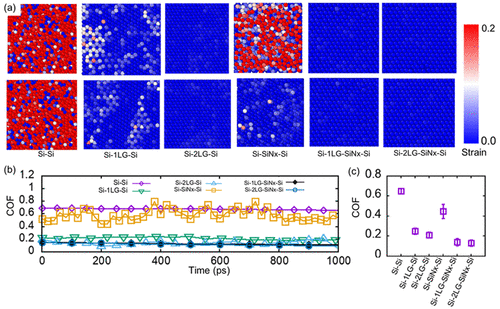当前位置:
X-MOL 学术
›
Nano Lett.
›
论文详情
Our official English website, www.x-mol.net, welcomes your
feedback! (Note: you will need to create a separate account there.)
Slippery and Wear-Resistant Surfaces Enabled by Interface Engineered Graphene.
Nano Letters ( IF 9.6 ) Pub Date : 2020-01-09 , DOI: 10.1021/acs.nanolett.9b03650 Neeraj Dwivedi 1 , Tarak Patra 2 , Jae-Bok Lee 3 , Reuben J Yeo 4 , Srilok Srinivasan 2 , Tanmay Dutta 5 , Kiran Sasikumar 2 , Chetna Dhand 1 , Sudhiranjan Tripathy 6 , Mohammad S M Saifullah 6 , Aaron Danner 5 , S A R Hashmi 1 , A K Srivastava 1 , Jong-Hyun Ahn 3 , Subramanian K R S Sankaranarayanan 2, 7 , Hyunsoo Yang 5 , Charanjit S Bhatia 5
Nano Letters ( IF 9.6 ) Pub Date : 2020-01-09 , DOI: 10.1021/acs.nanolett.9b03650 Neeraj Dwivedi 1 , Tarak Patra 2 , Jae-Bok Lee 3 , Reuben J Yeo 4 , Srilok Srinivasan 2 , Tanmay Dutta 5 , Kiran Sasikumar 2 , Chetna Dhand 1 , Sudhiranjan Tripathy 6 , Mohammad S M Saifullah 6 , Aaron Danner 5 , S A R Hashmi 1 , A K Srivastava 1 , Jong-Hyun Ahn 3 , Subramanian K R S Sankaranarayanan 2, 7 , Hyunsoo Yang 5 , Charanjit S Bhatia 5
Affiliation

|
Friction and wear remain the primary cause of mechanical energy dissipation and system failure. Recent studies reveal graphene as a powerful solid lubricant to combat friction and wear. Most of these studies have focused on nanoscale tribology and have been limited to a few specific surfaces. Here, we uncover many unknown aspects of graphene's contact-sliding at micro- and macroscopic tribo-scales over a broader range of surfaces. We discover that graphene's performance reduces for surfaces with increasing roughness. To overcome this, we introduce a new type of graphene/silicon nitride (SiNx, 3 nm) bilayer overcoats that exhibit superior performance compared to native graphene sheets (mono and bilayer), that is, display the lowest microscale friction and wear on a range of tribologically poor flat surfaces. More importantly, two-layer graphene/SiNx bilayer lubricant (<4 nm in total thickness) shows the highest macroscale wear durability on tape-head (topologically variant surface) that exceeds most previous thicker (∼7-100 nm) overcoats. Detailed nanoscale characterization and atomistic simulations explain the origin of the reduced friction and wear arising from these nanoscale coatings. Overall, this study demonstrates that engineered graphene-based coatings can outperform conventional coatings in a number of technologies.
中文翻译:

通过界面工程石墨烯实现的光滑耐磨表面。
摩擦和磨损仍然是机械能耗散和系统故障的主要原因。最近的研究表明,石墨烯是一种强大的固体润滑剂,可以抵抗摩擦和磨损。这些研究大多数集中在纳米级摩擦学上,并且仅限于一些特定的表面。在这里,我们发现了石墨烯在微观和宏观摩擦尺度下在更宽范围的表面上发生接触滑动的许多未知方面。我们发现,对于粗糙度增加的表面,石墨烯的性能会降低。为了克服这个问题,我们推出了一种新型的石墨烯/氮化硅(SiNx,3 nm)双层外涂层,其性能优于天然石墨烯片(单层和双层),即在一定范围内显示出最低的微尺度摩擦和磨损摩擦学上较差的平坦表面。更重要的是,两层石墨烯/ SiNx双层润滑剂(总厚度小于4 nm)在带头(拓扑变化的表面)上显示出最高的宏观磨损耐久性,超过了以前最厚的涂层(约7-100 nm)。详细的纳米级表征和原子模拟解释了这些纳米级涂层所产生的降低的摩擦和磨损的起因。总体而言,这项研究表明,在许多技术中,工程石墨烯基涂料的性能均优于传统涂料。详细的纳米级表征和原子模拟解释了这些纳米级涂层所产生的降低的摩擦和磨损的起因。总体而言,这项研究表明,在许多技术中,工程石墨烯基涂料的性能均优于传统涂料。详细的纳米级表征和原子模拟解释了这些纳米级涂层所产生的降低的摩擦和磨损的起因。总体而言,这项研究表明,在许多技术中,工程石墨烯基涂料的性能均优于传统涂料。
更新日期:2020-01-10
中文翻译:

通过界面工程石墨烯实现的光滑耐磨表面。
摩擦和磨损仍然是机械能耗散和系统故障的主要原因。最近的研究表明,石墨烯是一种强大的固体润滑剂,可以抵抗摩擦和磨损。这些研究大多数集中在纳米级摩擦学上,并且仅限于一些特定的表面。在这里,我们发现了石墨烯在微观和宏观摩擦尺度下在更宽范围的表面上发生接触滑动的许多未知方面。我们发现,对于粗糙度增加的表面,石墨烯的性能会降低。为了克服这个问题,我们推出了一种新型的石墨烯/氮化硅(SiNx,3 nm)双层外涂层,其性能优于天然石墨烯片(单层和双层),即在一定范围内显示出最低的微尺度摩擦和磨损摩擦学上较差的平坦表面。更重要的是,两层石墨烯/ SiNx双层润滑剂(总厚度小于4 nm)在带头(拓扑变化的表面)上显示出最高的宏观磨损耐久性,超过了以前最厚的涂层(约7-100 nm)。详细的纳米级表征和原子模拟解释了这些纳米级涂层所产生的降低的摩擦和磨损的起因。总体而言,这项研究表明,在许多技术中,工程石墨烯基涂料的性能均优于传统涂料。详细的纳米级表征和原子模拟解释了这些纳米级涂层所产生的降低的摩擦和磨损的起因。总体而言,这项研究表明,在许多技术中,工程石墨烯基涂料的性能均优于传统涂料。详细的纳米级表征和原子模拟解释了这些纳米级涂层所产生的降低的摩擦和磨损的起因。总体而言,这项研究表明,在许多技术中,工程石墨烯基涂料的性能均优于传统涂料。









































 京公网安备 11010802027423号
京公网安备 11010802027423号